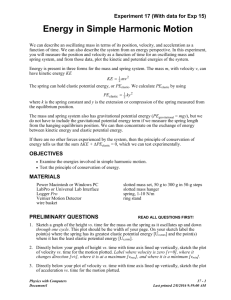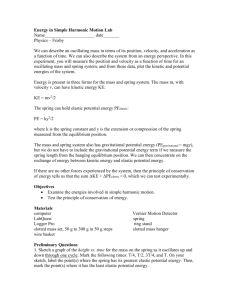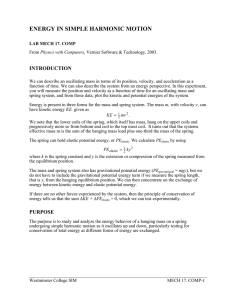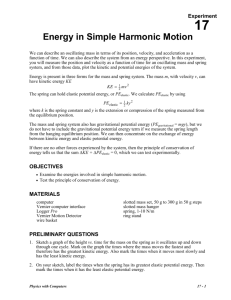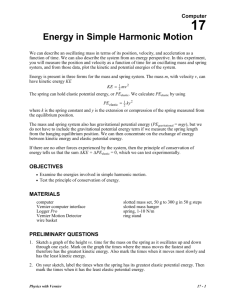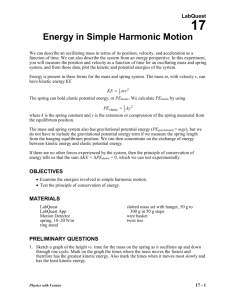17 Energy in SHM
advertisement
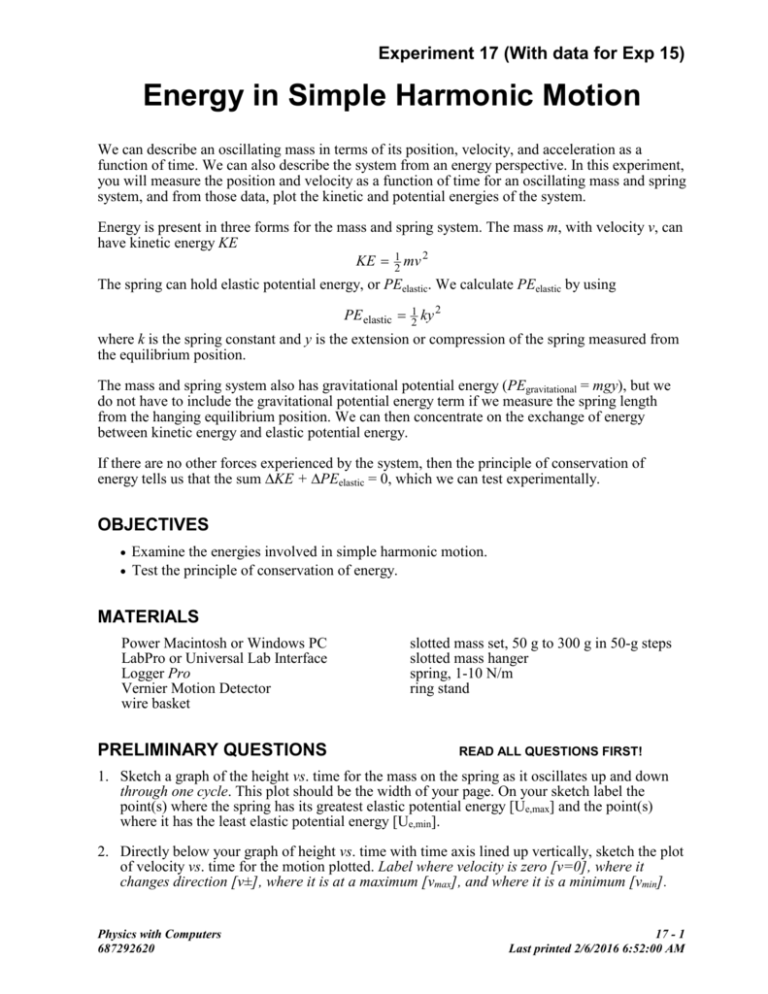
Experiment 17 (With data for Exp 15) Energy in Simple Harmonic Motion We can describe an oscillating mass in terms of its position, velocity, and acceleration as a function of time. We can also describe the system from an energy perspective. In this experiment, you will measure the position and velocity as a function of time for an oscillating mass and spring system, and from those data, plot the kinetic and potential energies of the system. Energy is present in three forms for the mass and spring system. The mass m, with velocity v, can have kinetic energy KE KE 21 mv 2 The spring can hold elastic potential energy, or PEelastic. We calculate PEelastic by using PE elastic 21 ky 2 where k is the spring constant and y is the extension or compression of the spring measured from the equilibrium position. The mass and spring system also has gravitational potential energy (PEgravitational = mgy), but we do not have to include the gravitational potential energy term if we measure the spring length from the hanging equilibrium position. We can then concentrate on the exchange of energy between kinetic energy and elastic potential energy. If there are no other forces experienced by the system, then the principle of conservation of energy tells us that the sum KE + PEelastic = 0, which we can test experimentally. OBJECTIVES Examine the energies involved in simple harmonic motion. Test the principle of conservation of energy. MATERIALS Power Macintosh or Windows PC LabPro or Universal Lab Interface Logger Pro Vernier Motion Detector wire basket PRELIMINARY QUESTIONS slotted mass set, 50 g to 300 g in 50-g steps slotted mass hanger spring, 1-10 N/m ring stand READ ALL QUESTIONS FIRST! 1. Sketch a graph of the height vs. time for the mass on the spring as it oscillates up and down through one cycle. This plot should be the width of your page. On your sketch label the point(s) where the spring has its greatest elastic potential energy [Ue,max] and the point(s) where it has the least elastic potential energy [Ue,min]. 2. Directly below your graph of height vs. time with time axis lined up vertically, sketch the plot of velocity vs. time for the motion plotted. Label where velocity is zero [v=0], where it changes direction [v±], where it is at a maximum [vmax], and where it is a minimum [vmin]. Physics with Computers 687292620 17 - 1 Last printed 2/6/2016 6:52:00 AM Experiment 17 3. Directly below your plot of velocity vs. time with time axis lined up vertically, sketch the plot of acceleration vs. time for the motion plotted. 4. Directly below your plot of acceleration vs. time with time axis lined up vertically, sketch three plots on one graph. These plots are kinetic energy vs. time, elastic potential energy vs. time, and total mechanical energy vs. time. 5. If a non-conservative force such as air resistance becomes important, the graph of total energy vs. time will change. Predict how the plots of K, Ue, and TE will look if an index card is taped to the bottom of the oscillating mass. 6. Open the sample data file listed with each part below. Complete the data and calculation tables using this sample data. You will need another copy of the tables for YOUR data and calculations. PROCEDURE 1. Mount the 200-g mass and spring as shown in Figure 1. Connect the Motion Detector to DIG/SONIC 2 of the LabQuest Mini. Position the Motion Detector directly below the hanging mass, taking care that no extraneous objects could send echoes back to the detector. Protect the Motion Detector by placing a wire basket over the detector. The mass should be at least 20 cm above the detector when it is at rest. Using amplitudes of 10 cm or less will then keep the mass outside of the 10 cm minimum distance of the Motion Detector. 2. To calculate the spring potential energy, it is necessary to measure the spring constant k. Hooke’s law states that the spring force is proportional to its extension from equilibrium, or F = –kx. You can apply a known force to the spring, to be balanced in magnitude by the spring force, by hanging a range of weights from the spring. The Motion Detector can then be used to measure the equilibrium position. Open the example data file for Exp 17b from the unit outline. Logger Pro is now set up to plot the applied weight vs. distance. Figure 1 3. Click to begin data collection. Hang ~50-g from the spring and allow the mass to hang motionless. Click Keep and enter the weight of the mass in newtons (N). Press ENTER to complete the entry. Now hang ~100, ~150, ~200, ~250, and ~300 g from the spring, recording the position and entering the weights in N. When you are done, click to end data collection. 4. Click on the Regression Line tool, , to fit a straight line to your data. The magnitude of the slope is the spring constant k in N/m. Record the value in the data table below. 5. Remove 50-g so the total mass is ~250-g. 6. Open the data file Exp 17ac from the course outline page. In addition to plotting position and velocity, three new data columns have been set up in this experiment file (kinetic energy, elastic potential energy, and the sum of these two individual energies). You may need to modify the calculations for the energies. If necessary, choose Modify Column Kinetic Energy from the Data menu and substitute the mass of your hanging mass in kilograms for the value 0.20 in the definition, then click . Similarly, change the spring constant you determined above for the value 5.0 in the potential energy column. 17 - 2 Physics with Computers Energy in Simple Harmonic Motion 7. With the mass hanging from the spring and at rest, click to zero the Motion Detector. From now on, all distances will be measured relative to this position. When the mass moves closer to the detector, the distance reported will be negative. 8. Start the mass oscillating in a vertical direction only, with an amplitude of about 10 cm. Click to gather position, velocity, and energy data. A clean sinusoidal plot should result. If the mass starts to oscillate other than vertically or the plot is not sinusoidal, repeat data collection. 9. Tape an index card to the bottom of your hanging mass. Collect a second set of data. Don’t forget to rezero the motion detector. 10. Remove the notecard and change the mass to 450 g. Rezero and repeat data collection. DATA TABLE Spring constant N/m ANALYSIS Complete these questions for each trial: minimal damping, index-card damping. Include printouts of your data, with appropriate dialogue boxes shown. 1. Click on the y-axis label of the velocity graph to choose another column for plotting. Uncheck the velocity column and select the kinetic energy and potential energy columns. Click to draw the new plot. 2. Compare your two energy plots to the sketches you made earlier. Be sure you compare to a single cycle beginning at the same point in the motion as your predictions. Comment on any differences. 3. If mechanical energy is conserved in this system, how should the sum of the kinetic and potential energies vary with time? Sketch your prediction of this sum as a function of time. 4. Check your prediction. Click on the y-axis label of the energy graph to choose another column for plotting. Select the total energy column in addition to the other energy columns. Click to draw the new plot. 5. From the shape of the total energy vs. time plot, what can you conclude about the conservation of mechanical energy in your mass and spring systems? 6. Does the frequency, f, appear to depend on the amplitude of the motion? Does damping affect the frequency? Justify your answers using the data collected. 7. Where in the motion is velocity at a minimum, maximum, and zero? Repeat for acceleration, KE, and U. Organize your answers by creating an appropriate table. [Hint: top end point, bottom end point, equilibrium.] 8. Go back to your answers to the Preliminary Questions. Modify as needed. Physics with Computers 17 - 3 Experiment 17 FOLLOW UP 1. Go to the following SHM simulators / tutorials and explore: http://www.ngsir.netfirms.com/englishhtm/SpringSHM.htm. http://www.physics.uoguelph.ca/tutorials/shm/Q.shm.html http://www.phy.ntnu.edu.tw/ntnujava/index.php?topic=148.0 (UN: malsin, PW: 16200) 2. Read §11.2 – 11.6 3. Know how to do: Questions (ch 11): 2, 5 Problems (ch 11): 1, 3, 5, 9, 17, 21, 22 EXTRA CREDIT 1. In the introduction, we claimed that the gravitational potential energy could be ignored if the displacement used in the elastic potential energy was measured from the hanging equilibrium position. First write the total mechanical energy (kinetic, gravitational potential, and elastic potential energy) in terms of a coordinate system, distance measured upward and labeled y, whose origin is located at the bottom of the relaxed spring of constant k (no force applied). Then determine the equilibrium position s when a mass m is suspended from the spring. This will be the new origin for a coordinate system with distance labeled h. Write a new expression for total energy in terms of h. Show that when the energy is written in terms of h rather than y, the gravitational potential energy term cancels out. [To earn the extra credit you will be required to do this problem at an unannounced time with no materials. Your answer will be graded as either full credit, half-credit, or no credit based on the completeness and correctness of your answer. Half-credit will require much more than half-correct.] 17 - 4 Physics with Computers
